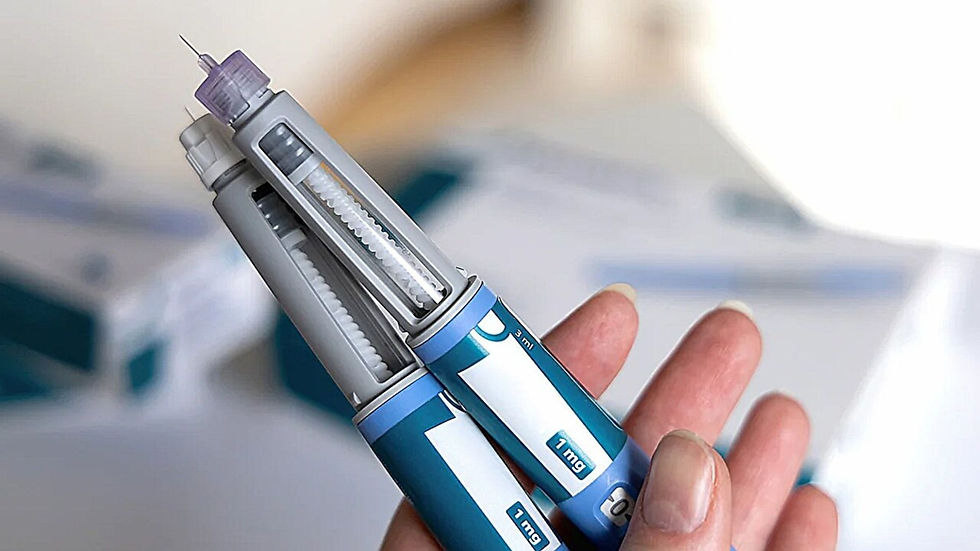Can Wegovy doses be adjusted based on weight loss progress?
- AJ Hill Aesthetics

- 5 days ago
- 4 min read
Your dose isn’t weight-based (not mg/kg). Clinicians adjust along a standard titration ladder primarily for tolerability and clinical response, not solely the number on the scale. If side effects bite, a longer hold at the current step or staying at 1.7 mg can be sensible; if well tolerated and response is appropriate, moving to 2.4 mg is typical. Continuation is reviewed at service checkpoints against agreed benchmarks; don’t self-change the dose.
Why Wegovy dosing isn’t tied to body weight

Wegovy (semaglutide) uses fixed weekly doses rather than milligram-per-kilogram calculations. Its benefits and side-effect profile were established at specific weekly strengths in trials, not body-adjusted doses. The aim is to achieve steady exposure that your system can tolerate and sustain. This differs from drugs such as certain antibiotics or anticoagulants, where dose depends on body mass or kidney function. With Wegovy, the essentials are simple: use an approved step, inject correctly into the fatty layer, and maintain a regular weekly rhythm so levels stay consistent.
How the titration ladder works
The usual sequence is 0.25 mg for 4 weeks, 0.5 mg for 4, 1.0 mg for 4, 1.7 mg for at least 4, then 2.4 mg weekly as maintenance. Each step allows your gut to adapt and helps limit nausea, reflux, or dizziness. If a phase feels comfortable, your prescriber moves you up; if symptoms persist, they can extend or pause. The ladder is deliberately gradual so treatment remains tolerable and steady. NICE TA875 and NHS England’s 2025 commissioning framework both stress that prescribers should individualise timing without exceeding licensed dose limits.
When and why clinicians adjust

Adjustments reflect comfort and overall clinical response, not rapid weight change. For example, if nausea or reflux are troublesome, your clinician may keep you at the current step longer and review supportive measures. If you’re stable and meeting goals, they may move you to 2.4 mg. Some people remain at 1.7 mg long-term because it balances benefit and comfort. Several patients note that holding a dose during stressful or travel periods helps them stay consistent. In the STEP-5 trial, steady progress continued even among those who stayed below 2.4 mg for longer, underscoring that tolerance predicts adherence more than speed of escalation. The SELECT trial later reinforced that cardiovascular benefits were maintained at the full 2.4 mg maintenance dose, supporting its role once comfort is established.
Reviews and continuation criteria
NHS services include checkpoints—often around week 16 and later—to confirm benefit and tolerability. Reviews consider not just kilograms lost but also appetite control, blood pressure, glucose, and wellbeing. NICE TA875 and NHS England commissioning guidance suggest continuing only if clinically meaningful progress is shown, typically about 5% weight reduction by 16 weeks. If progress is limited despite adherence, your team may address barriers or discuss alternatives. In Scotland and Wales, SMC and AWTTC guidance follow similar continuation thresholds. These reviews are not “tests of success” but opportunities to individualise pacing, troubleshoot side effects, and support confidence before moving forward.
Why self-adjustment is risky
Taking extra doses for faster results or halving doses to stretch supply can both backfire. Higher doses raise nausea and dehydration risk; lower doses weaken appetite control. Doubling after a missed dose is unsafe. MHRA safety alerts emphasise that unsupervised changes can destabilise treatment and mask side-effects. Consistency, not improvisation, supports the metabolic changes that Wegovy promotes. NICE also underlines that semaglutide’s effects depend on a steady weekly rhythm and sustained engagement with lifestyle support.
Recognising when to pause or proceed

Hold a step if nausea, reflux, constipation, or dizziness persist; proceed when appetite is controlled and symptoms settle. A brief “dose diary” noting date, dose, site, and side-effects helps clinicians decide precisely when to move on. Bringing this to appointments keeps reviews factual and brief. NHS staff often say that predictable patterns — such as reduced nausea after the fourth or fifth injection at a step — help guide safe progression.
Special circumstances

If you also use insulin or a sulphonylurea, other medicines may be adjusted as your appetite and glucose control improve, though the Wegovy dose ladder itself stays fixed. Around surgery or sedation, clinicians may time injections to reduce aspiration risk because Wegovy slows stomach emptying. Significant illness, dehydration, or pregnancy planning may also prompt temporary holds—all directed by your team, never self-decided. NICE and MHRA guidance both advise discussing any major health or medication changes before altering your schedule.
Making dose changes smoother
Tolerability improves with small, regular meals, adequate protein and fibre, good hydration, and limiting heavy or spicy food during escalation. Site rotation prevents soreness; a fresh needle and holding the pen until the indicator completes ensure full delivery. If you miss a dose, follow your clinic’s five-day rule instead of catching up. Aligning dose steps with calmer weeks can make transitions easier. NHS services sometimes recommend pairing dose changes with follow-up calls, so support is close at hand during adjustment phases.
Lessons we can draw
Wegovy dosing is standardised for safety, not tailored to body weight. Clinicians adjust only for tolerance and overall progress. The right dose is the one you can sustain comfortably, usually 2.4 mg once weekly, though some remain at 1.7 mg. Regular reviews and honest communication keep treatment safe and effective. Following the plan, rather than chasing faster results, is what delivers long-term success — and the structured clinical support built into NICE-approved programmes ensures each step forward remains manageable and sustainable.





Comments